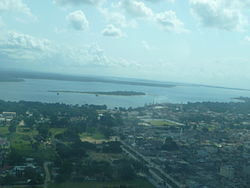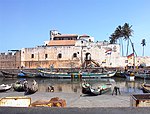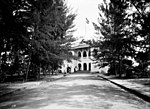User:Luziyca/Sandbox: Difference between revisions
No edit summary |
No edit summary |
||
| Line 57: | Line 57: | ||
==Etymology== | ==Etymology== | ||
The name '''Port Graham''' derives from | The name '''Port Graham''' derives from Captain [[Reynold Graham]], and was initially known as [[Fort Graham]]. However, due to its location along the Rwizikuran coast, the community growing up along the fort became informally known as Port Graham, while the fort itself kept the name of Fort Graham. Thus, in 1869, it was officially renamed by the Estmerish colonisers as Port Graham. | ||
The {{wp|Shona language|weRwizi}} name, '''Nhare''' derives from the weRwizi word for fortress, "nhare," referring to Fort Graham. In the 1960s, it was suggested to rename Port Graham to Nhare, but [[Izibongo Ngonidzashe]] vetoed the idea, as he believed that "it is inappropriate for cities founded by Eucleans to lose their Euclean names. However, in 1965, he allowed Nhare to be used alongside Port Graham. | The {{wp|Shona language|weRwizi}} name, '''Nhare''' derives from the weRwizi word for fortress, "nhare," referring to Fort Graham. In the 1960s, it was suggested to rename Port Graham to Nhare, but [[Izibongo Ngonidzashe]] vetoed the idea, as he believed that "it is inappropriate for cities founded by Eucleans to lose their Euclean names. However, in 1965, he allowed Nhare to be used alongside Port Graham. | ||
However, Nhare was not always the weRwizi name: when Estmere first established Fort Graham, [[Reynold Graham]] recorded the name as '''Seesheshee''', which is believed to be '''Zvisheshi''', which is a contraction of '''zvishoma chiteshi''', meaning "little harbour." | |||
==History== | ==History== | ||
===Pre-slave trade=== | |||
The site of what is now Port Graham has been continuously inhabited since 650 BCE. As it is situated on the mouth of the [[Mutezo River]], the settlement, while not as important as [[Munzwa]] or [[Chekumabvazuva|Guta reMabwe]] (present-day [[Chekumabvazuva]]), was an important settlement. | |||
The settlement was believed to have been visited by [[Don Pilote]] in the 1330s, as Pilote had reported that the settlement was "a welcoming gateway," and noted the high quality of the roads between it and the capital of the [[veRwizi Empire]] in Munzwa. | |||
===Slave trade=== | |||
[[File:Elmina_slave_castle.jpg|150px|thumb|left|[[Fort Graham]], 1998]] | |||
In 1638, [[Estmere]] negotiated an agreement with the local chief, [[Munaki Mutezo]], to establish [[Fort Graham]] as a trade post. | |||
With its establishment, it quickly became the most important trading post, as slaves were sold to the Estmerish at Fort Graham, in exchange for [[Euclea|Euclean]] goods, such as {{wp|guns}} and books. As well, Fort Graham became the main administrative centre for Estmere's other trade posts, as Estmere negotiated with other chiefs to establish trade posts, especially following the collapse of the [[veRwizi Empire]] in the 1650s. | |||
Thus, by 1680, Fort Graham was seen as the main centre of power, as the local overseers of the trade posts were based there, with the surrounding community becoming one of the largest cities following the fall of [[Munzwa]]. This helped enrich the Mutezo family, which governed the Bahian inhabitants, but at the same time forced the Mutezos to engage in wars to take more slaves to trade to the Estmerish, as demand for slaves increased, especially in the Asterias. | |||
However, with the [[Gilded Wars]], Estmerish influence started declining, as the forts were taken over either by [[Gaullica]], or else were taken over by other native tribes, resulting in Fort Graham being the only fort remaining under Estmerish control by 1721. This helped increase its status, as by this point, virtually all slaves from Rwizikuru sent to [[Kingsport]] came through Fort Graham. | |||
This would come to a halt in the 1740s, when Estmere abolished {{wp|slavery}} and the slave trade: all of a sudden, trade at Fort Graham ceased to be profitable, as there was suddenly no resource from the region that could replace slaves. While over the next few decades, explorers tried to find resources to replace slaves, such as minerals, or wood, by 1803, the officials concluded that "there is no real value in maintaining a fort when the only resources that this corner of Bahia has to offer are the people." Thus, they abandoned Fort Graham. | |||
===Nineteenth century=== | |||
With the departure of [[Estmere]] from present-day Port Graham, the Mutezo family now had nominal control over the area, and they took over [[Fort Graham]]. However, the end of slavery meant that their main source of wealth had dried up, which greatly weakened the [[Hourege|Masimbe system]] used not by the Mutezos, but also all other rulers within the general region. | |||
During this time, the power of the Mutezo family diminished, as the [[Sâre|village system]] became more prominent among the communities surrounding present-day Port Graham. By the 1840s, it was believed that the Mutezo family only had real control over Fort Graham and its immediate environs, with local chiefs having displaced the Mutezo family outside this immediate area. | |||
The Mutezo family maintained control over Port Graham until 1868, when [[Charles Fitzhubert]] and his army retook control of Fort Graham after a pitched battle against the Mutezo family. | |||
===Establishment of colonial rule=== | |||
[[File:Bundesarchiv_Bild_105-DOA0169,_Deutsch-Ostafrika,_Tanga,_Bezirksamt.jpg|150px|thumb|right|City hall, 1906]] | |||
With the reconquest of Port Graham, some officials in [[Estmere]] sought to move the capital from [[Port Fitzhubert]] to Port Graham, as Port Graham was seen as more central compared to Port Fitzhubert, and as it had served as the main Estmerish centre of power during the slave trade. However, Charles Fitzhubert was unwilling to move the capital away from Port Fitzhubert, as Fitzhubert argued that the [[Mutezo River]] was not as navigable as the [[Rwizikuru River]], which meant that they would not be able to get as far inland as they otherwise would. | |||
Despite this decision, the colonial authorities did not neglect Port Graham altogether, as its position at the mouth of the Mutezo River meant it was well-suited to development. | |||
Thus, [[Richard Fitzgerald]] was commissioned to design a "new city" on the western bank of the Mutezo River, as opposed to the old city on the eastern bank, with Fitzgerald deciding on a {{wp|gridiron plan}} of five avenues going north to south, and ten streets going east to west, with a central square in the middle of Port Graham, much like Port Fitzhubert. | |||
By 1871, Port Graham was reported to have 1,209 inhabitants, with only sixteen [[Murungu (Rwizikuru)|white people]], with the remainder being Bahian. During the 1870s, the town developed a "modern harbour," and became one of the main commercial centres of [[Rwizikuru#Recolonization|Riziland]], second only to Port Fitzhubert. This meant that by 1881, it had 6,503 people, including thirty whites, and eleven [[Nokara|Hyndanans]]. | |||
By 1891, Port Graham had reached 11,496 people, which meant that in 1893, it was granted city status, making it the second settlement in Riziland to be granted city status after the capital city, Port Fitzhubert. | |||
(TBC) | (TBC) | ||
==Geography== | |||
Port Graham is situated on the mouth of the [[Mutezo River]], where it exits into the [[Banfura Sea]]. It is flat and low-lying, and is divided by the Mutezo River. | |||
While [[Fort Graham]] and the oldest buildings are situated on the eastern side of the Mutezo River, the main commercial district is situated on the western side of the river. | |||
Revision as of 13:06, 3 December 2019
Port Graham
Nhare | |
|---|---|
City | |
 | |
| Motto(s): Runyararo uye kurongeka (weRwizi) Peace and honour | |
| Country | File:RwizikuruFlag.PNG Rwizikuru |
| District | Ndarira |
| Founded | 1638 |
| Government | |
| • Mayor | Munaki Nhiwatiw |
| Population (2011) | |
| • City | 571,937 |
| • Rank | 4th in Rwizikuru |
| • Urban | 571,937 |
| • Metro | 631,937 |
| Time zone | UTC-6 (Rwizi Standard Time) |
| • Summer (DST) | UTC-6 (not observed) |
Port Graham is the fourth largest city of Rwizikuru and the district seat of the Ndarira district. Established in 1638, it is the oldest Estmerish settlement in present-day Rwizikuru, and served as a centre for the slave trade from Bahia to Estmere and her colonies across the world until slavery's abolition in the 1740s.
Following this, the area went into decline, with Port Graham ceasing to be capital of Riziland when Estmere left the area in 1803. When Estmere returned in the late nineteenth century, it was supplanted by Port Fitzhubert as the capital of Riziland.
Etymology
The name Port Graham derives from Captain Reynold Graham, and was initially known as Fort Graham. However, due to its location along the Rwizikuran coast, the community growing up along the fort became informally known as Port Graham, while the fort itself kept the name of Fort Graham. Thus, in 1869, it was officially renamed by the Estmerish colonisers as Port Graham.
The weRwizi name, Nhare derives from the weRwizi word for fortress, "nhare," referring to Fort Graham. In the 1960s, it was suggested to rename Port Graham to Nhare, but Izibongo Ngonidzashe vetoed the idea, as he believed that "it is inappropriate for cities founded by Eucleans to lose their Euclean names. However, in 1965, he allowed Nhare to be used alongside Port Graham.
However, Nhare was not always the weRwizi name: when Estmere first established Fort Graham, Reynold Graham recorded the name as Seesheshee, which is believed to be Zvisheshi, which is a contraction of zvishoma chiteshi, meaning "little harbour."
History
Pre-slave trade
The site of what is now Port Graham has been continuously inhabited since 650 BCE. As it is situated on the mouth of the Mutezo River, the settlement, while not as important as Munzwa or Guta reMabwe (present-day Chekumabvazuva), was an important settlement.
The settlement was believed to have been visited by Don Pilote in the 1330s, as Pilote had reported that the settlement was "a welcoming gateway," and noted the high quality of the roads between it and the capital of the veRwizi Empire in Munzwa.
Slave trade

In 1638, Estmere negotiated an agreement with the local chief, Munaki Mutezo, to establish Fort Graham as a trade post.
With its establishment, it quickly became the most important trading post, as slaves were sold to the Estmerish at Fort Graham, in exchange for Euclean goods, such as guns and books. As well, Fort Graham became the main administrative centre for Estmere's other trade posts, as Estmere negotiated with other chiefs to establish trade posts, especially following the collapse of the veRwizi Empire in the 1650s.
Thus, by 1680, Fort Graham was seen as the main centre of power, as the local overseers of the trade posts were based there, with the surrounding community becoming one of the largest cities following the fall of Munzwa. This helped enrich the Mutezo family, which governed the Bahian inhabitants, but at the same time forced the Mutezos to engage in wars to take more slaves to trade to the Estmerish, as demand for slaves increased, especially in the Asterias.
However, with the Gilded Wars, Estmerish influence started declining, as the forts were taken over either by Gaullica, or else were taken over by other native tribes, resulting in Fort Graham being the only fort remaining under Estmerish control by 1721. This helped increase its status, as by this point, virtually all slaves from Rwizikuru sent to Kingsport came through Fort Graham.
This would come to a halt in the 1740s, when Estmere abolished slavery and the slave trade: all of a sudden, trade at Fort Graham ceased to be profitable, as there was suddenly no resource from the region that could replace slaves. While over the next few decades, explorers tried to find resources to replace slaves, such as minerals, or wood, by 1803, the officials concluded that "there is no real value in maintaining a fort when the only resources that this corner of Bahia has to offer are the people." Thus, they abandoned Fort Graham.
Nineteenth century
With the departure of Estmere from present-day Port Graham, the Mutezo family now had nominal control over the area, and they took over Fort Graham. However, the end of slavery meant that their main source of wealth had dried up, which greatly weakened the Masimbe system used not by the Mutezos, but also all other rulers within the general region.
During this time, the power of the Mutezo family diminished, as the village system became more prominent among the communities surrounding present-day Port Graham. By the 1840s, it was believed that the Mutezo family only had real control over Fort Graham and its immediate environs, with local chiefs having displaced the Mutezo family outside this immediate area.
The Mutezo family maintained control over Port Graham until 1868, when Charles Fitzhubert and his army retook control of Fort Graham after a pitched battle against the Mutezo family.
Establishment of colonial rule
With the reconquest of Port Graham, some officials in Estmere sought to move the capital from Port Fitzhubert to Port Graham, as Port Graham was seen as more central compared to Port Fitzhubert, and as it had served as the main Estmerish centre of power during the slave trade. However, Charles Fitzhubert was unwilling to move the capital away from Port Fitzhubert, as Fitzhubert argued that the Mutezo River was not as navigable as the Rwizikuru River, which meant that they would not be able to get as far inland as they otherwise would.
Despite this decision, the colonial authorities did not neglect Port Graham altogether, as its position at the mouth of the Mutezo River meant it was well-suited to development.
Thus, Richard Fitzgerald was commissioned to design a "new city" on the western bank of the Mutezo River, as opposed to the old city on the eastern bank, with Fitzgerald deciding on a gridiron plan of five avenues going north to south, and ten streets going east to west, with a central square in the middle of Port Graham, much like Port Fitzhubert.
By 1871, Port Graham was reported to have 1,209 inhabitants, with only sixteen white people, with the remainder being Bahian. During the 1870s, the town developed a "modern harbour," and became one of the main commercial centres of Riziland, second only to Port Fitzhubert. This meant that by 1881, it had 6,503 people, including thirty whites, and eleven Hyndanans.
By 1891, Port Graham had reached 11,496 people, which meant that in 1893, it was granted city status, making it the second settlement in Riziland to be granted city status after the capital city, Port Fitzhubert.
(TBC)
Geography
Port Graham is situated on the mouth of the Mutezo River, where it exits into the Banfura Sea. It is flat and low-lying, and is divided by the Mutezo River.
While Fort Graham and the oldest buildings are situated on the eastern side of the Mutezo River, the main commercial district is situated on the western side of the river.
